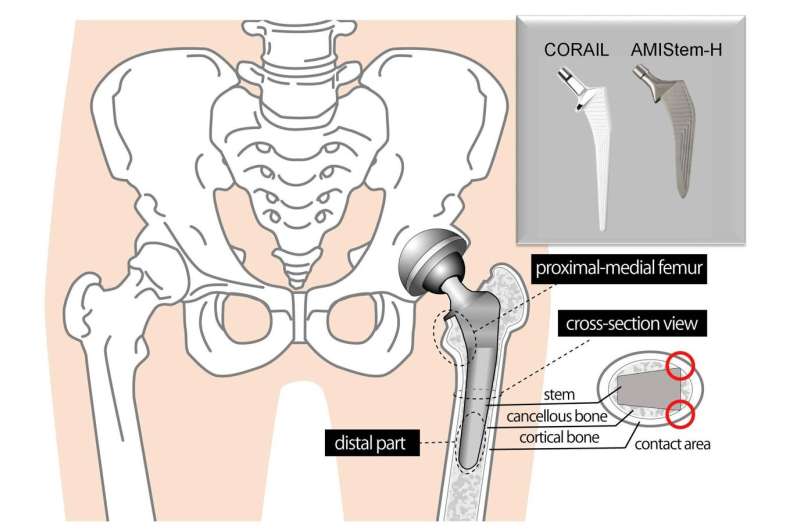This article has been reviewed according to Science X's editorial process and policies. Editors have highlighted the following attributes while ensuring the content's credibility:
fact-checked
trusted source
proofread
Staying hip to orthopedic advances: Comparing traditional and new hip replacement stems

Needing a hip replacement is unfortunate, but even more unfortunate is to need to do it again. Surgeons at Osaka Metropolitan University have provided new insights into the performance of two types of stems used in total hip replacement surgery. Their findings are expected to contribute to the enhancement of long-term outcomes, improving patients' quality of life and reducing the need for revision surgeries.
Their paper was published in The Bone & Joint Journal on June 1.
The hip joint, which connects the femur, or thighbone, to the pelvis, plays a crucial role in supporting body weight and facilitating movement. Total hip replacement, or total hip arthroplasty, involves replacing a damaged hip joint with an implant to alleviate pain and stiffness caused by disease or aging.
"After surgery, a decrease in bone density around the femur can increase the risk of fractures and loosening of the artificial joint, necessitating hip revision surgery," said Yohei Ohyama, lead author, surgeon, and Ph.D. candidate at the Osaka Metropolitan University Graduate School of Medicine.
The team therefore conducted a detailed analysis of bone density changes and stem-femur contact between two types of stems used in total hip replacement: traditional fully hydroxyapatite (HA)-coated stems and newly introduced fully HA-coated stems.
Hydroxyapatite is a naturally-occurring mineral form of calcium apatite and a major component in bone. The traditional HA stems are renowned for their excellent long-term results, while the new HA stems—which are shorter—are designed for minimally invasive surgery.
The study included 66 patients, with 36 receiving the traditional HA stems and 30 receiving the new HA stems. Bone density around the implants was measured using dual-energy X-ray absorptiometry one year and two years post-surgery. A 3D density mapping system assessed stem contact with femoral cortical bone.
Results indicated significantly larger contact areas in certain femur regions with the new HA stems. Conversely, the traditional HA stems showed increased bone density around the upper inner femur (proximal-medial femur) at the two-year mark, compared to a decrease in the new HA stems.
The study highlights the distinct fixation patterns and bone density preservation capabilities of the two stem types. The new HA stems have larger adequate contact areas. However, the traditional HA stems demonstrate superior long-term preservation of bone density.
These findings are critical for surgeons when selecting stems for total hip replacement, aiming to optimize patient outcomes and ensure implant longevity.
"Total hip arthroplasty is a life-enhancing procedure that extends patients' healthy lifespans and improves their quality of life," Ohyama said. "We hope our findings will contribute to treatment strategies that make artificial joints a lifetime solution."
More information: Yohei Ohyama et al, Contact states with femoral cortical bone and periprosthetic bone mineral density changes differ between traditional and newly introduced fully hydroxyapatite-coated stems, The Bone & Joint Journal (2024). DOI: 10.1302/0301-620X.106B6.BJJ-2023-1157.R2





















